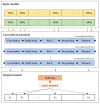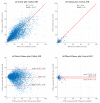Prediction of the Sleep Apnea Severity Using 2D-Convolutional Neural Networks and Respiratory Effort Signals
- PMID: 37892008
- PMCID: PMC10605440
- DOI: 10.3390/diagnostics13203187
Prediction of the Sleep Apnea Severity Using 2D-Convolutional Neural Networks and Respiratory Effort Signals
Abstract
The high prevalence of sleep apnea and the limitations of polysomnography have prompted the investigation of strategies aimed at automated diagnosis using a restricted number of physiological measures. This study aimed to demonstrate that thoracic (THO) and abdominal (ABD) movement signals are useful for accurately estimating the severity of sleep apnea, even if central respiratory events are present. Thus, we developed 2D-convolutional neural networks (CNNs) jointly using THO and ABD to automatically estimate sleep apnea severity and evaluate the central event contribution. Our proposal achieved an intraclass correlation coefficient (ICC) = 0.75 and a root mean square error (RMSE) = 10.33 events/h when estimating the apnea-hypopnea index, and ICC = 0.83 and RMSE = 0.95 events/h when estimating the central apnea index. The CNN obtained accuracies of 94.98%, 79.82%, and 81.60% for 5, 15, and 30 events/h when evaluating the complete apnea hypopnea index. The model improved when the nature of the events was central: 98.72% and 99.74% accuracy for 5 and 15 events/h. Hence, the information extracted from these signals using CNNs could be a powerful tool to diagnose sleep apnea, especially in subjects with a high density of central apnea events.
Keywords: abdominal respiratory signal; central sleep apnea; convolutional neural network; deep learning; obstructive sleep apnea; thoracic respiratory signal.
Conflict of interest statement
The authors declare no conflict of interest.
Figures





Similar articles
-
Deep-Learning Model Based on Convolutional Neural Networks to Classify Apnea-Hypopnea Events from the Oximetry Signal.Adv Exp Med Biol. 2022;1384:255-264. doi: 10.1007/978-3-031-06413-5_15. Adv Exp Med Biol. 2022. PMID: 36217089
-
A 2D convolutional neural network to detect sleep apnea in children using airflow and oximetry.Comput Biol Med. 2022 Aug;147:105784. doi: 10.1016/j.compbiomed.2022.105784. Epub 2022 Jun 28. Comput Biol Med. 2022. PMID: 35797888
-
Sleep Apnea Detection Based on Thoracic and Abdominal Movement Signals of Wearable Piezo-Electric Bands.IEEE J Biomed Health Inform. 2016 Nov;21(6):1533-1545. doi: 10.1109/JBHI.2016.2636778. Epub 2016 Dec 7. IEEE J Biomed Health Inform. 2016. PMID: 28114046
-
Advancements in Home-Based Devices for Detecting Obstructive Sleep Apnea: A Comprehensive Study.Sensors (Basel). 2023 Nov 30;23(23):9512. doi: 10.3390/s23239512. Sensors (Basel). 2023. PMID: 38067885 Free PMC article. Review.
-
Duration of respiratory events in obstructive sleep apnea: In search of paradoxical results.Sleep Med Rev. 2023 Apr;68:101728. doi: 10.1016/j.smrv.2022.101728. Epub 2022 Nov 30. Sleep Med Rev. 2023. PMID: 36521320 Review.
Cited by
-
An Automated Algorithm for Obstructive Sleep Apnea Detection Using a Wireless Abdomen-Worn Sensor.Sensors (Basel). 2025 Apr 10;25(8):2412. doi: 10.3390/s25082412. Sensors (Basel). 2025. PMID: 40285102 Free PMC article.
-
A deep learning algorithm model to automatically score and grade obstructive sleep apnea in adult polysomnography.Digit Health. 2024 Oct 17;10:20552076241291707. doi: 10.1177/20552076241291707. eCollection 2024 Jan-Dec. Digit Health. 2024. PMID: 39430691 Free PMC article.
References
-
- Berry R.B., Budhiraja R., Gottlieb D.J., Gozal D., Iber C., Kapur V.K., Marcus C.L., Mehra R., Parthasarathy S., Quan S.F., et al. Rules for Scoring Respiratory Events in Sleep: Update of the 2007 AASM Manual for the Scoring of Sleep and Associated Events. Deliberations of the Sleep Apnea Definitions Task Force of the American Academy of Sleep Medicine. J. Clin. Sleep Med. 2012;8:597. doi: 10.5664/jcsm.2172. - DOI - PMC - PubMed
-
- Epstein L.J., Kristo D., Strollo P.J., Friedman N., Malhotra A., Patil S.P., Ramar K., Rogers R., Schwab R.J., Weaver E.M., et al. Clinical Guideline for the Evaluation, Management and Long-term Care of Obstructive Sleep Apnea in Adults. J. Clin. Sleep Med. 2009;5:263. doi: 10.5664/jcsm.27497. - DOI - PMC - PubMed
Grants and funding
LinkOut - more resources
Full Text Sources

